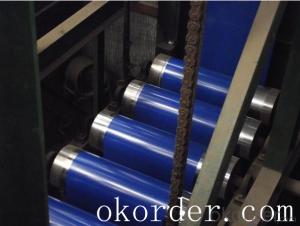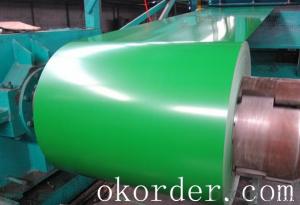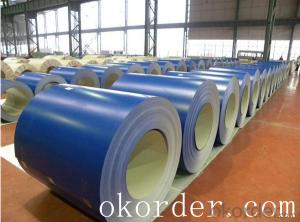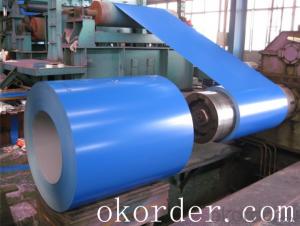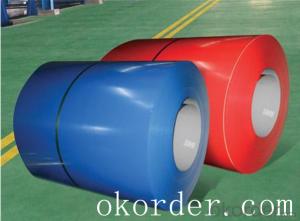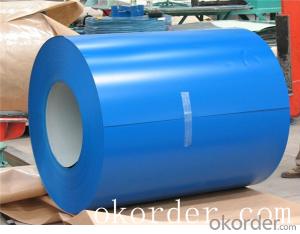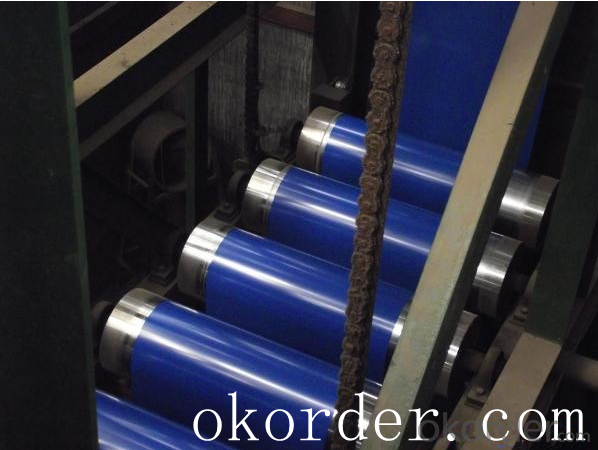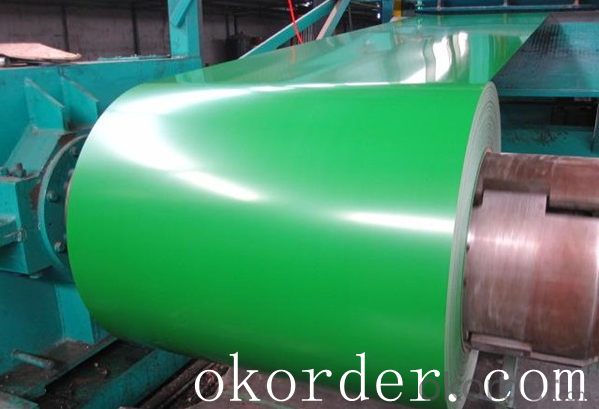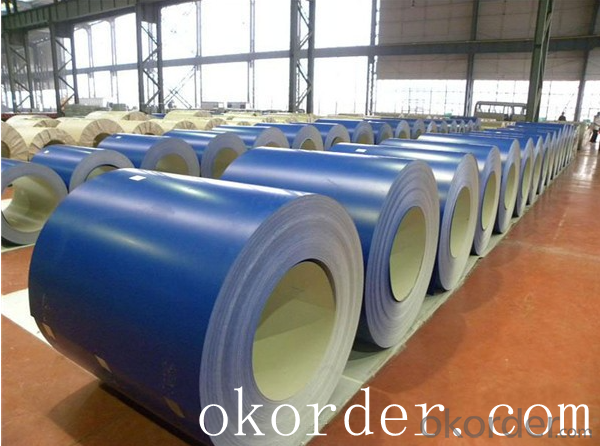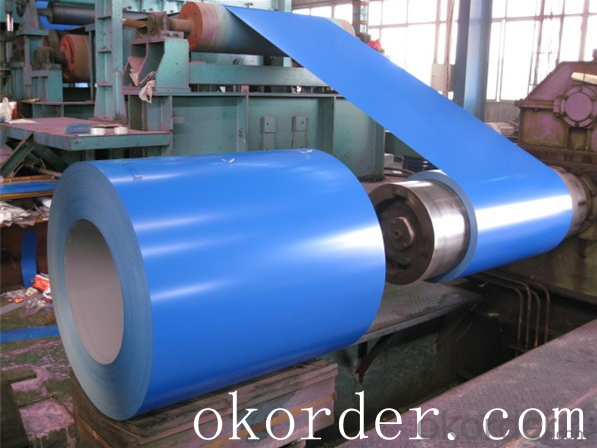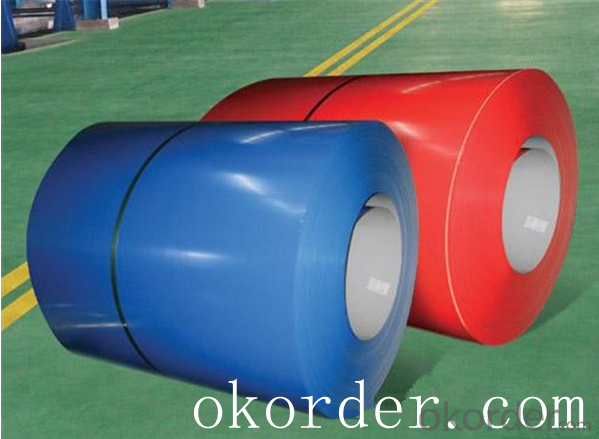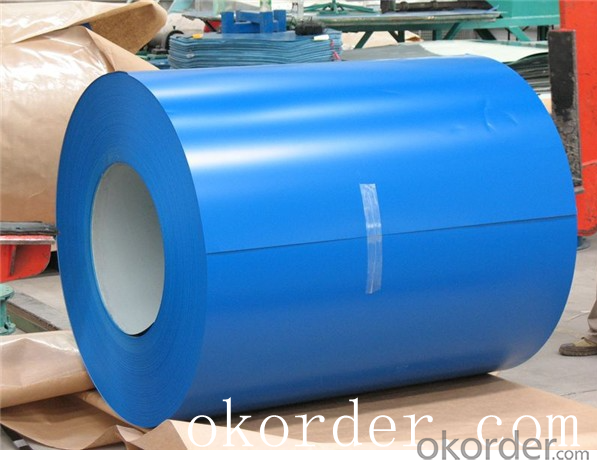Prime quality prepainted galvanized steel 625mm
- Loading Port:
- Tianjin
- Payment Terms:
- TT OR LC
- Min Order Qty:
- 100 m.t.
- Supply Capability:
- 10000 m.t./month
OKorder Service Pledge
OKorder Financial Service
You Might Also Like
Construction building material galvanized color prepainted cold
rolled steel coil
Prepainted steel sheet is coated with organic layer, which provides higher anti-corrosion property and
a longer lifespan than that of galvanized steel sheets.
The base metals for prepainted steel sheet consist of cold-rolled, HDG electro-galvanized and hot-dip
Alu-zinc coated. The finish coats of prepainted steel sheets can be classified into groups as follows:
polyester, silicon modified polyesters, polyvinylidene fluoride, high-durability polyester, etc
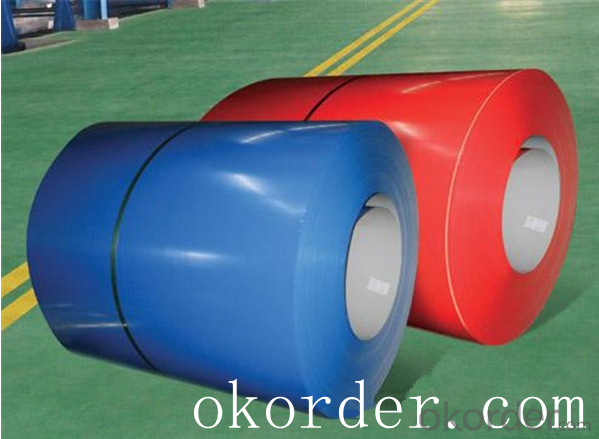
Standard and Grade :
Pre-paint galvanized steel coil | ||||
ASTM A755M-03 | EN10169:2006 | JISG 3312-2012 | ||
Commercial quality | CS | DX51D+Z | CGCC | |
Structure steel | SS GRADE 230 | S220GD+Z | CGC340 | |
SS GRADE 255 | S250GD+Z | CGC400 | ||
SS GRADE 275 | S280GD+Z | CGC440 | ||
SS GRADE 340 | S320GD+Z | CGC490 | ||
SS GRADE550 | S350GD+Z | CGC570 | ||
S550GD+Z | ||||
Application:
Outdoor | Roof, roof structure, surface sheet of balcony, frame of window, door of garage, rolled shutter door, booth, Persian blinds, cabana, etc |
Indoor | Door, isolater, frame of door, light steel structure of house, home electronic appliances, ect. |
- Q: What types of steel are commonly used for billets?
- The types of steel commonly used for billets include carbon steel, alloy steel, and stainless steel.
- Q: What are the common sizes and dimensions of steel billets?
- The common sizes and dimensions of steel billets vary widely depending on the specific industry and application. However, some common dimensions include square shapes ranging from 100x100mm to 300x300mm and rectangular shapes with dimensions of 200x300mm to 400x600mm. Additionally, cylindrical billets typically have diameters ranging from 100mm to 300mm. It is important to note that these dimensions can differ significantly based on the requirements of the end-use industry.
- Q: What are the different methods of surface treatment for steel billets?
- There are several different methods of surface treatment for steel billets, each serving a specific purpose and offering unique benefits. Some of the most common methods include: 1. Pickling: This process involves immersing the steel billets in an acid solution to remove any surface impurities, such as rust or scale. Pickling helps to improve the surface finish and prepare the steel for further treatment or processing. 2. Shot blasting: In this method, steel billets are bombarded with high-speed steel shots or grits to remove surface contaminants and create a uniform texture. Shot blasting is commonly used to remove rust, scale, or paint, and it can also improve the adhesion of subsequent coatings or paints. 3. Galvanizing: This surface treatment involves coating the steel billets with a layer of zinc to provide corrosion resistance. Galvanizing can be done through hot-dip galvanizing, where the steel is immersed in a molten zinc bath, or through electroplating, where a thin layer of zinc is deposited on the surface using an electric current. 4. Painting or powder coating: Steel billets can be painted or powder coated to provide both aesthetic appeal and protection against corrosion. Paints or powder coatings create a barrier between the steel surface and the environment, preventing moisture and other corrosive agents from reaching the metal. 5. Passivation: This method involves treating the steel billets with a chemical solution, typically an acid, to remove any free iron or iron oxide from the surface. Passivation helps to enhance the corrosion resistance of stainless steel and other alloys by creating a passive oxide layer that protects against further oxidation or rusting. 6. Nitriding: Nitriding is a surface hardening treatment where the steel billets are exposed to a nitrogen-rich atmosphere at elevated temperatures. This process diffuses nitrogen into the surface of the steel, forming a hardened layer that increases wear resistance and improves fatigue strength. 7. Chrome plating: Steel billets can be coated with a layer of chromium through electroplating, providing enhanced corrosion resistance and a shiny appearance. Chrome plating is often used in applications where aesthetics and durability are important, such as automotive parts or decorative fixtures. These are just a few examples of the different methods of surface treatment for steel billets. The choice of method depends on factors such as the desired outcome, the specific properties required, and the intended application of the steel billets.
- Q: What are the different types of straightening methods used for steel billets?
- Steel billets can be straightened using various methods, depending on specific requirements and desired outcomes. These methods encompass: 1. Roller Straightening: By passing the steel billets through a series of rollers, pressure is applied in different directions to achieve straightness. Rollers can be adjusted to target specific areas that may be bent or twisted. 2. Hydraulic Straightening: Employing hydraulic presses, pressure is exerted on the billets either in a single or multiple directions. Adjustments can be made to attain the desired level of straightness. 3. Heat Straightening: This method involves heating the bent or twisted sections of the steel billets and using hydraulic or mechanical tools to straighten them. The heat softens the steel, simplifying the reshaping process. 4. Hammering: A conventional technique where skilled workers manually reshape the billets using hammers and anvils. This method necessitates a high level of skill and precision to achieve the desired straightness. 5. Magnetic Straightening: Employing magnetic fields, this non-contact method applies forces to the steel billets and straightens them. It is often implemented for smaller and thinner billets to avoid damage or distortion caused by other methods. Each straightening method has its own advantages and limitations. The choice of method depends on various factors, such as billet size and thickness, required level of straightness, and available equipment and resources.
- Q: Billet prices skyrocketing weekend, Southern China steel prices rose?
- In December 5th, the billet price in Hebei was 2780 yuan per ton, a new high since two years and three months, a rise of more than 85% over the same period of last year.
- Q: How are steel billets used in the production of agricultural harvesting equipment?
- Steel billets are used as a raw material in the production of agricultural harvesting equipment. They are melted, cast, and then shaped into various components such as blades, teeth, and shafts that are essential for the efficient functioning of the equipment. The strength and durability of steel make it an ideal choice for withstanding the demanding conditions and heavy-duty operations involved in agriculture.
- Q: How do steel billets contribute to the manufacturing of electrical appliances?
- Steel billets play a vital role in the manufacturing of electrical appliances by providing a strong and durable material for various components. Electrical appliances, such as refrigerators, washing machines, and air conditioners, require sturdy structures to withstand constant usage and external forces. Steel billets, which are semi-finished metal products, are used as a raw material in the manufacturing process to create these robust structures. Firstly, steel billets are forged or rolled into different shapes and sizes to create the frames, chassis, and housing of electrical appliances. These components provide the necessary support and protection for the internal parts of the appliances. The strength and stability of steel make it an ideal choice for withstanding the weight and vibrations generated during the operation of electrical appliances. Additionally, steel billets are used to fabricate the motor cores and transformer cores in electrical appliances. Motor cores are essential for converting electrical energy into mechanical energy, while transformer cores are responsible for regulating the voltage in electrical circuits. Steel's magnetic properties, such as high electrical conductivity and low hysteresis loss, make it an excellent choice for these applications, ensuring efficient energy conversion and transmission. Moreover, steel billets are utilized to manufacture heating elements and electrical contacts in appliances like stoves, ovens, and switches. These components require materials that can withstand high temperatures, resist corrosion, and provide excellent electrical conductivity. Steel billets are often alloyed with other metals, such as nickel or chromium, to enhance these properties, making them highly suitable for such applications. In conclusion, steel billets contribute significantly to the manufacturing of electrical appliances by providing a durable and versatile material for various components. The strength, stability, and magnetic properties of steel make it an essential raw material for creating the frames, motor cores, transformer cores, heating elements, and electrical contacts used in these appliances. Thanks to steel billets, electrical appliances can perform reliably and efficiently, meeting the needs and expectations of consumers.
- Q: What are the different types of steel billet rolling techniques?
- There are several different types of steel billet rolling techniques, including hot rolling, cold rolling, and continuous casting.
- Q: What is the role of steel billets in the manufacturing of storage systems?
- Steel billets play a crucial role in the manufacturing of storage systems as they serve as the raw material for the production of various steel components used in these systems. These billets are heated, rolled, and shaped to create beams, columns, and other structural elements that provide strength and stability to the storage systems. Additionally, steel billets can be further processed to create shelves, racks, and other storage components, ensuring durability and reliability in the overall design.
- Q: What are the different surface defects that can occur in steel billets?
- Some of the different surface defects that can occur in steel billets include cracks, scales, pitting, scratches, and surface irregularities.
Send your message to us
Prime quality prepainted galvanized steel 625mm
- Loading Port:
- Tianjin
- Payment Terms:
- TT OR LC
- Min Order Qty:
- 100 m.t.
- Supply Capability:
- 10000 m.t./month
OKorder Service Pledge
OKorder Financial Service
Similar products
Hot products
Hot Searches
Related keywords
